CHINESE DOG BREEDS
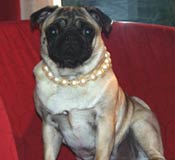
Pug, thought to
be from China Dog breeds indigenous to China include the chow chow, Pekingese and shar pei. Because China was closed to outsiders for such a long time, the outside world knew little of these dogs until relatively recently. This has also meant that their genes have not entered breeds that originated from Europe.
Chinese breeds did not really appear outside of China until around 1780. Some were smuggled out of China by sailors in the 1800s. A few of these dogs were displayed at the London Zoo under the sign “Wild Dogs of China.” These dogs had been fed grains their whole life and had a hard time adapting to Western meat diets.
Articles on PETS IN CHINA factsanddetails.com BrinGing Pets to China China.org question ; One-Dog Policy in China www.independent.co.uk ; Dog and Cat Meat Ban guardian.co.uk ; Dog Life Photos foreignpolicy.com ; Wikipedia article on Chinese Dog Breeds Wikipedia
Pekingese
The Pekingese, according to American Kennel Club, “combines marked dignity with an exasperating stubbornness, which serves only to endear him the more to his owners, He is independent and regal in every gesture; it would be a great indignity to attempt to make a lap dog out of him. Calm and good-tempered, the Pekinese employs a condescending cordiality toward the world in general, but in the privacy of his family enjoys nothing better than a good romp. Although never aggressive, he fears not the devil himself and has never known to turn tail and run.”

Pekingese were considered sacred in imperial times. The earliest known record of them is from the Tang Dynasty in the 8th century. Dog idols that resembled Pekinese were made of ivory, bronze, wood and other materials. Sometimes they were encrusted with jewels. For many years only the Chinese Imperial family was allowed to own them and the theft of one was a crime punishable by death.
Names for Pekingese have included lion dog, a reference to its thick man, not its use in hunting lions; sun dog, an allusion to the brilliant, golden color of it coat; and sleeve dog, a reference to fact it was so small it could be fit in to the sleeve of Mandarin-style costume.
Pekingese were first introduced to the West after the looting of the Summer Palace outside Beijing by the British in 1860. There were reports of many dead Pekingese found throughout the palace. Apparently their owners had preferred to see them dead than captured by the British. Four dogs found behind a curtain (their owner, an aunt of the Emperor, committed suicide) were given to Queen Victoria as a gift. Some other were taken by the Duke of Richmond who started breeding them
Shar Pei
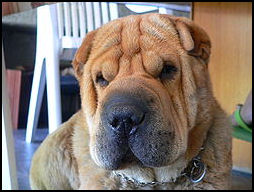
The shar pei was once listed as the world's rarest breed by the Guinness Book of World records. Also known as the Chinese fighting dog, it has been praised for its courage and tenaciousness but is known today mostly for the loose folds of bristly skin all over its face and often all over its body.
Shar pei is Cantonese for “sandy skin.” The breed originated in an area near Guangzhou (Canton) in Guangdong Province. Clay statues from the Han Dynasty (202 B.C. to A.D. 220) depict shar-pei-like dogs. They were not an imperial breed and were associated mostly with peasants who used them for a number purposes: herding livestock, hunting, protection. They have traditionally been big dogs. They were eaten and their skins provided clothing.
Shar pei were originally not trained to fight, but were forced into the sport when dog fight fighting became popular around a hundred years ago. The loose skin was an advantage when it fought. A shar pei could still turn and bite when opponents grabbed the folds and opponents weren’t fond of biting the bristly folds any way.
Shar pei were often not willing fighters. There were stories of them being fed alcohol, drugs and even gunpowder to make them fight better. They were no match for a pit bulls, bulldogs and other fighting dogs that were introduced to China from the West. When dogs were banned during the Mao era, the shar pei breed was kept alive by Hong Kong breeders and continued to survive in remote rural areas.
Website: Hong Kong Shar Pei Club: www.sharpeiclubhk.com
Shar Pei Characteristics
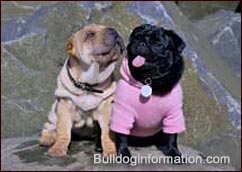
The wrinkled folds are especially pronounced on shar pei puppies, who often have so many wrinkles they look like an animal trapped in a potato sack. These wrinkles diminish somewhat as the dog matures. Shar pei originally were not supposed to have wrinkled folds all over their body. One description of the breed’s goes: “Strong, compact, active and agile. The skin must be tough and rough while the coat must be short and bristly. Tight wrinkles over the body at puppy stage. In the adult dog, pronounced wrinkling only around the forehead and withers.”
The frowning forehead wrinkles should resemble the shape of the Chinese character for longevity. Its tail is supposed to reach over the back like a “sickle” or a “double ring coin.” Like the chow chow, the shar pei has a blueish black tongue and mouth. The shar pei is generally quiet. When it does bark it make a throaty “chuffing” noise before all out barking.
Shar pei also have small ears, a trait associated with many fighting dogs, and have a head that has been compared with that of a hippopotamus. They have curved teeth that create a locked bite that in fights was difficult for opponent’s to break. Many owners say that shar pei’s appearance is not what attracts them. They value the dog’s intelligence and loyalty and say they are great house and family dogs.
Shar Pei Problems
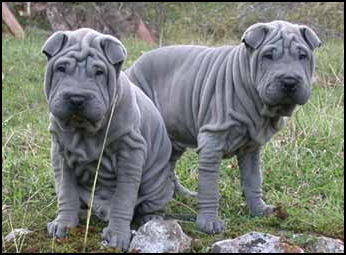
Shar pei puppies sell for around $1,000 in the United States and $700 in Britain. In Hong Kong and southern China they sell for only $300. Inbreeding and crossbreeding with chow chows, bulldogs and bull terriers has produced shar pei dogs with a number of health problems,
The problems began in the 1970s when the American magazine Dog World urged dog lovers “to save the Chinese sher pei from extinction.,” giving the impression that only a few remained. Shei peis of all kinds were exported to the United States, where they became all the rage and sold for thousands of dollars. With greed as a primary motivation, they were bred no matter what their family history was and in some cases cross bred with bulldogs to increase their wrinkling. The general feeling was the wrinkles were cute and the more of them the better.
The inbreeding caused genetic problems and the wrinkles turned shar peis into “walking skin problems.” The skins proved be an ideal breeding ground for bacteria and fungus. Many shar peis suffer from teh dkin disease mange dermatitis. Some animals have terrible itching and infection problems. They develop sores. The yeasty bacteria that grows in the folds gives them an unpleasant smell.
Many shar pei suffer from entropion, a painful condition in which excessive folding around the eyes causes the eyelashes to turn inward and rub against the eyeball. If untreated it can cause blindness. The folds can also drop over the lips into the mouth — a condition sometimes called “meatmout”—and make eating difficult and painful. Face-lift-like surgery is sometimes necessary to correct the problems. In recent years, an effort has been made to track down pure breed shar peis in China and restore genetic diversity and restore the health of the breed.
Shar-pei Genetic Mutations
Shar-peis are an ancient Chinese dog breed characterized by two singular traits: thick, wrinkly skin and frequent bouts of fever. The wrinkles were a result of excess production of a substance called hyaluronic acid distributed throughout the dogs’ skin. That excess is likely caused by to the overactivation of a gene called hyaluronan synthase 2. [Source: New York Times, March 22, 2011]
Researchers now say that the same gene mutation is responsible for both the wrinkles and the fever. “All shar-pei dogs have this mutation that causes the wrinkles, but the more copies they have, the higher the risk to have this fever,” Mia Olsson, a doctoral student at Uppsala University in Sweden who worked on the study, told the New York Times. The research appears in the journal PLoS Genetics. Dogs that carry multiple mutations of the gene seem predisposed to periodic fever, Ms. Olsson and her colleagues reported. Although the fever is short-lived, it can be intense and frequent, and cause inflammation. March 22, 2011
With more information, breeders might be able to avoid breeding shar-peis that have duplications of the gene mutation, Ms. Olsson said. The research was conducted with the help of breeders in the United States, Sweden and Spain. “Our highest priority right now is to see if there’s some way to create some kind of test or tool to reduce the number of dogs with the fevers,” she said. The fever closely resembles certain periodic fevers that humans inherit, and studying the mutation in the dogs could help human geneticists develop treatments. The most common periodic fever among humans is known as familial Mediterranean fever. It tends to affect people of Mediterranean and Middle Eastern descent, and there is no cure.
Chow Chows
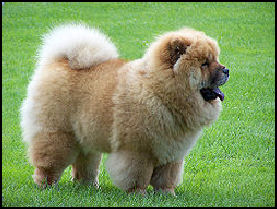
Chow chows are the breed of dog perhaps most closely associated with China. They are big dogs, standing 20 inches or so at the shoulder, and weigh 45 to 70 pounds, They come in variety of colors and are known best for their long, thick coats of hair and mains, which makes them look a bit like lions.
The breed’s name is thought to have been derived from the pidgin English term chow chow, a broad term used to describe anything novel. Others believe it comes rom the Chinese word “chou”, meaning edible. In China, the dog goes by various names, including “hei she-t’ou” (“black tongued”), “kwantung kous” (“Canton dog”), “lang kou” (“lion dog”) and “hsiun kou” (“bear dog”).
Chow Chows are believed to be one of the oldest dog breeds. They seem to be relatives of Tibetan Mastiffs and Nordic Spitz dogs such as the Samoyed of northern Siberia. Some historians trace the dogs back to 11th century B.C. invasion of China by Mongol-like tribes. Reliefs from the Han Dynasty (202 B.C. to A.D. 220) depict Chowlike dogs engaged in hunting. An 8th century Tang emperor is said to have had 5,000 chows and an staff of 10,000 huntsmen.
Chows were used as guard dogs and hunting dogs. Marco Polo described them being used to pull sledges. They were highly valued as a source of meat. The upperclass fed them an all grain diet and butchered them when they were young. Their long hair was used to make clothing.
In the early 1900s chow chows were fairly plentiful. They were sold in markets as pets. During this period many chows found their way abroad. This was fortunate because the breed suffered in China under Communist rule, particularly during the Cultural Revolution.
Chow Chow Characteristics

Chow chows are strong and fast. They are still used in China to hunt Mongolian pheasants and a kind of Yunnan bird. They have massive heads and wrinkled faces that make them look as if they are scowling. Their long hair requires constant brushing and grooming and can make the dogs very uncomfortable in the summer.
The standard of the breed description of the American Kennel Club goes: “A massive, cobby, powerful dog, active and alert, with strong muscular development, and perfect balance...head, broad and flat, with short, broad and deep muzzle, accentuated by a ruff; the whole supported by straight, strong legs. Clothed in a shining, offstanding coat, the Chow is a masterpiece of beauty, dignity and untouched naturalness.”
Chow chows have blue-back tongues, lips and gums, which are also found on polar bears and a few Asiatic bear. This and the fact that chow chow puppies are little furballs that resemble teddy bears lead many Chinese to believe they descended from bears.
Chow Chows have a reputation for being independent, suspicious, nasty to strangers, aloof, and rude. It is said they will protect their family and territory to the death. Dangerfield and Howell wrote in the International Encyclopedia of Dogs, “It has been said that the Chow will die for his master but not readily obey him; walk with him but not trot meekly to heel; honor him, but not fawn on his friends and relations.”
Chow chows have been involved in some serous attacks on people in the United States. There were 44 percent less of them in the U.S. in 1994 than in 1990.
Hairless Chinese Crested
The Chinese crested is a hairless breed that some people regard as ugly and others view as charming. Sometimes referred to as “Treasure House Guardians,” they were bred by mandarins and members of the Han family and have a history in China that my go back hundreds of years. They were made famous in America by the flamboyant stripper Gypsy Rose Lee, who owned several of them and took them with her wherever she went.
According to the book “A Celebration of Rare Breeds”, “The Chinese crested is a fine boned, small dog who is wonderfully graceful. His ears are erect and rather large. His almond shaped eyes are dark and radiate warmth...The Chinese crested has long and amazingly dexterous toes. Owners say they can curl their toes around your fingers. Males measure less than 13 inches at the shoulder, while females may not exceed 12 inches.”
Like other hairless breeds, the Chinese crested is not completely hairless. It gets it name from the “crest” of hair on its head that is often tied into a topknot. They also have hair on their feet, which is often referred to as socks, and small plumes on their tail. The skin is very warm and some say it is has a satiny feel.
Chinese crested dogs are a hairless species like the Mexican hairless and the Peruvian hairless. It was discovered in 2008 that a single gene, which scientists call FOX13, is responsible for the baldness.
Tibetan Dogs

Tibetan mastiff
Many Tibetan cities and villages are filled with stray dogs. The killing of animals, especially dogs, is considered a sin in Tibetan Buddhism. Tibetan Buddhism holds that dogs are the last reincarnation before rebirth as human. Many dogs live in packs around temples, surviving off handouts by monks and tourists.
Pet dogs are greatly valued and pampered. There is a dog sign and “year of the dog” on the Tibetan calendar as there is on the Chinese calendar. Dogs found in the Tibetan countryside can quite fierce. For protection against dogs Tibetans carry a heavy tapered metal rod with a leather chord known as a "goubang."
Tibetan mastiffs used to own the streets of Lhasa at night. Now they are largely gone. One reason for this is a massive culling of dogs that took place in the early 2000s. The culling greatly angered Buddhists. Dog ownership is discouraged by the Chinese and for a while was banned but is now permitted within limits.
There are four primary breeds native to Tibet: the Tibetan terrier, the Tibetan spaniel, the Tibetan mastiff and the Lhasa Apso. All these dogs have two common features: long heavy coats of hair to keep them warm in the Tibetan winters and tails that curl up over their backs. The KyiApos, or bearded sheepdog of Tibet, is a very rare breed.
See Separate Article TIBETAN DOGS factsanddetails.com
Image Sources: bulldog.com, Wikipedia, Amercican Tibetan Mastiff Association
Text Sources: New York Times, Washington Post, Los Angeles Times, Times of London, National Geographic, The New Yorker, Time, Newsweek, Reuters, AP, Lonely Planet Guides, Compton’s Encyclopedia and various books and other publications.
Last updated July 2011
